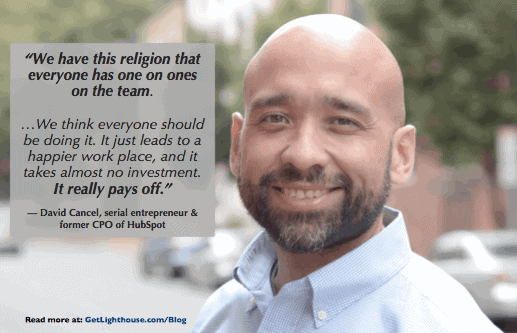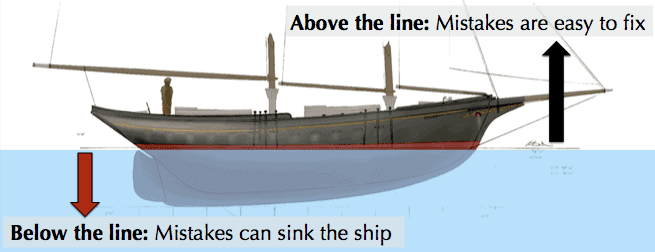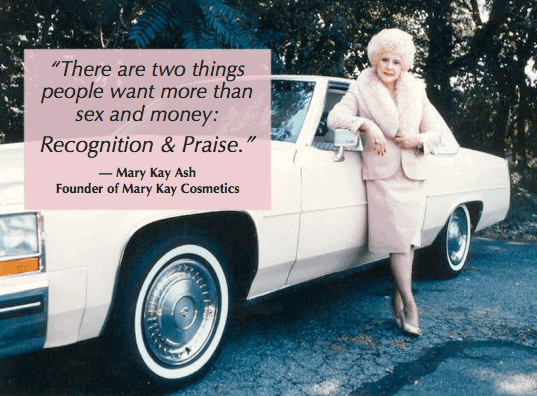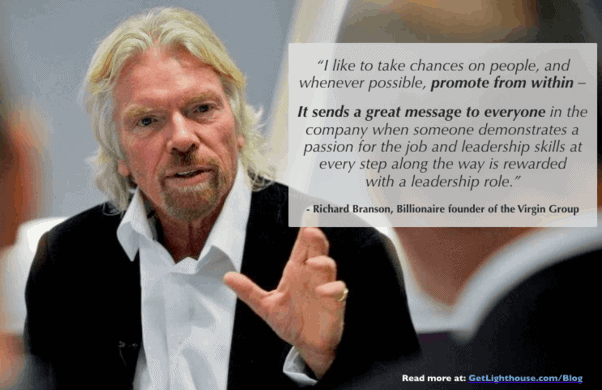What makes high-performing teams at big companies like Amazon, Adobe, and GE, as well as startups like Buffer so special?
Today, we'll show you. The good news is that these are all fundamental ideas you can use with a minimal amount of practice. The "bad” news, is that they require consistency and determination. These are key habits, not one-time magical, silver bullets.
If you want you and your team to adopt them, you have to put in effort on a regular basis. As obvious as this sounds, not a lot of managers are willing to do that. However, if you are willing to put in the effort, this means you'll really stand out and become the kind of leader that gets recognized and promoted.
With that in mind, let's discuss the 5 habits that can turn your average team into a high-performing team.
5 Key Characteristics of High Performing Teams
It would be impossible to list all the things that characterize the best teams in the world. However, we've been able to find 5 examples of strategies that have worked for them and why they're so effective. They are:
- Having regular, quality 1:1s
- Accepting mistakes and learning from them
- The right amount of recognition
- Doubling down on people's strengths
- Promoting from within
Let's dive into the research on these habits and the experiences of managers who know they work. At the end of each section, we'll give you further reading with detailed advice on how you can apply them to your team.

1. You have weekly or biweekly, quality 1:1s
It's hard to put a real value on 1:1s. At least, that's what we used to think. Fortunately, there's now ample data to measure this crucial soft skills tool.
Research on regular 1:1s shows they can positively impact productivity and engagement, reduce stress, solve bottled-up frustrations, and a number of other things.
According to Gallup: "On average, only 15% of employees who work for a manager who does not meet with them regularly are engaged; managers who regularly meet with their employees almost tripled that level of engagement."
Meanwhile, a 2021 report from MHA has shown that regularly talking to a manager to change stressful things about work was strongly correlated with the healthiest overall workplaces.
And thanks to implementing regular 1:1s, GE was able to "drive a fivefold productivity increase in just one year.”
Across industries, it's clear just how fundamentally important 1:1s are to high-performing teams. However, many leaders miss out on their potential by not having them at all or by not preparing for them well enough.
Regular 1:1s turbocharge productivity - here's how to start
When you're trying to establish a new habit, it's easy to feel uncertain of what to do.
To help you, we've prepared these tips for effective one on ones that can help you develop high-performing teams.
Establish a regular cadence
A key aspect of one on ones working well is that you have a consistent schedule for them. When you and your team member can know a meeting is taking place, you're more likely to think about things you can discuss and address various topics. There's no single answer to how often you should have 1:1s, but we recommend every week or every other week that lasts 60 minutes.
Push through awkward
You and your team members may naturally be good at conversing with each other. However, there's also the possibility of the conversation not going so smoothly. That's perfectly fine.
Your first couple of one on ones with a team member will most likely be a bit awkward. If you push through it, you'll find you both will start looking forward to them.
To help you have less awkward conversations, we've prepared a list of 130+ one on one questions you can bring up in various contexts during your check-ins.
Wrapping up, following through, and closing the loop
One on ones should usually end on a high note. Even if you touch on some difficult subjects, the goal of the meeting is to help resolve them and make life easier for your team member. The best way to do that is to wrap up each meeting by thinking of action items you need to do by next time.
To really close the loop and make meetings meaningful, though, make sure to address the action items from the last one on one with them. This ensures you're making progress by holding you both accountable. It also builds confidence, as you both feel the progress being made on issues that are important to them.
Here are some other ways to organize your 1:1s like a real pro:
- Why Your One on One Needs a Meeting Agenda, because just a little preparation goes a really long way
- Effective One on One meeting template, one of the most comprehensive guides you'll find.
- One on One Meeting Questions Great Managers Ask Their Teams, so you can always keep the conversation going and get your team to open up

2. You learn from your mistakes
Learning from mistakes is one of the most important principles at Amazon. According to Jeff Bezos:
"One area where I think we are especially distinctive is failure. I believe we are the best place in the world to fail (we have plenty of practice!), and failure and invention are inseparable twins.
To invent you have to experiment, and if you know in advance that it's going to work, it's not an experiment.”
If you look at all the business lines Amazon has now, and their many innovations, you can see they've tried many things. And importantly, not all of them have worked. Remember their Fire phone, Quidsi, or Groupon clone, Amazon Local?
You have to try things that may not work to find the things that will work.
Another fascinating example of a leader who values failure is Joel Thor Neeb, a former US Air Force Pilot trainer. He said the trainees who realize mistakes are part of the journey are the ones who make it through his training more often than others:
"High-performing teams don't always win. They just never fail the same way twice. While in pursuit of inventing the light bulb, Thomas Edison said, "I haven't failed – I've just found 10,000 ways that won't work”. Today, no one talks about those 10,000 failures, and your team's failures will be a distant memory if they iteratively improve after each mistake.
My students always understood that if they could recover from their mistakes there would be a good chance they would pass the mission and go on to see their dreams come true. Give your organization the option to fail. Empower your teams to fail early and fail often when the stakes are small, so that they can win big when it matters. If you can do that, you'll be well on your way to building a high-performance team.”
Are you making room for your team to make mistakes?

Use the water line to safely embrace failure
Neeb is referring to what's known as the Waterline Principle, an idea that was popularized by company W.L. Gore:
"The waterline principle means that it's ok to make a decision that might punch a hole in the boat as long as the hole is above the waterline so that it won't potentially sink the ship.
But, if the decision might create a hole below the waterline which might cause the ship to sink, then associates are encouraged to consult with their team so that a collaborative decision can be made.”
If you're unsure how to give your team the freedom to fail like many other managers, start with the Waterline Principle. Encourage more independence and risk-taking where the consequences of making mistakes will not severely hurt your company or team.
It's a fairly simple way to take a balanced approach to fail and contribute to a more open way of thinking in your team. It also has the potential to accelerate everyone's development by giving people more opportunities to learn from experience.
We've written other posts about learning from mistakes and making it okay to fail, which you can learn about here:
- Chaos Theory and Management: Learning from Systems in Nature
- Why You Should Prioritize Psychological Safety to have an Innovative Team

3. You praise your team regularly
Giving praise is one of the most overlooked, yet critical, aspects of managing. And founder of Walmart, Sam Walton, is far from the only leader who believes in its power.
Here are a couple of other examples of people who understood its value:
American businesswoman Mary Kay Ash, creator of the Mary Kay Cosmetics empire, once said:
"I believe that you should praise people whenever you can; It causes them to respond as a thirsty plant responds to water.”
Best selling author of How to Win Friends and Influence People, Dale Carnegie wrote:
"People work for money but go the extra mile for recognition, praise and rewards."
However, the evidence behind the effectiveness of praise isn't just anecdotal. Researchers and psychologists Heaphy and Losada came to the conclusion that:
"The factor that made the greatest difference between the most and least successful teams was the ratio of positive comments to negative comments… The average ratio for the highest-performing teams was 5.6… The medium-performance teams averaged 1.9… But the average for the low-performing teams, at 0.36 to 1, was almost three negative comments for every positive one.”
The data on praise is clear: it has the power to dramatically change how people feel and improve the caliber of work they produce for your team.
That's why as a manager, you shouldn't feel like this is a big task you don't have time for.

3 steps to become better at praising
To show your team you genuinely care about them and don't take them for granted, set aside a few minutes each week to reflect on something positive they've done. One of the secrets of effective praise is to give it frequently. Don't assume your team knows how you feel and celebrate success often.
Another key to keeping your team motivated and happy is to specifically acknowledge what you liked in their work (i.e.- "I like your attention to detail in the report” or "Your charts in slides 3 and 4 were spot on”). This shows them you really paid attention, and they'll know exactly what to do to be praised again. This ensures you also avoid brief, hollow ‘good jobs', as they'll create the opposite effect of what you were hoping for.
Finally, be strategic about how you give praise. Use it to develop your people. Choose something each person on your team could improve on and work with them on it. Then, as you see them get better at it, praise their progress specifically. They'll soon start to light up and thrive. Even more importantly, they'll stay hungry and continue to get better as time goes on.
To learn how to truly master the skill of praising to create high-performing teams, check out the following links:

4. You double down on your people's strengths
It's easy to think high-performing teams are perfect and have no weaknesses. In truth, many of them have learned how to effectively hide weaknesses and focus on what they're good at instead.
It's a principle that has worked for Facebook as Sheryl Sandberg has remarked. It's also been backed up by research, too. According to Gallup:
"People who focus on their strengths every day are 6 times more likely to be engaged in their jobs, more productive and more likely to say they have an excellent quality of life.”
Ben Horowitz, former CEO of Opsware and investor at a16z, understands this and wrote it about in his book, "The Hard Thing About Hard Things”:
"The more experience you have, the more you realize that there is something seriously wrong with every employee in your company (including you). Literally, nobody is perfect.
As a result, it is imperative that you hire for strength rather than lack of weakness…Hiring for lack of weakness just means that you'll optimize for pleasantness. Rather, you must figure out the strengths you require and find someone who is world-class in those areas despite their weaknesses in other, less important domains.”
As counterintuitive as it sounds, most high-performing teams don't prioritize dealing with weaknesses. Their leaders know that everyone wants to feel successful and allow them to do the work they love most.

Put people in the best possible position to succeed
Focusing on improving weaknesses can sometimes be good (as we've discussed in this post), but to truly get the best performances from your team, make sure they're thriving by doing the things they love and have the greatest skills for.
The roles and responsibilities you give them are key to that. As Gallup's Marcus Buckingham writes:
"Excellent teams are built around individual excellence. Therefore, the manager's first responsibility is to make sure each person is positioned in the right role.”
And how would you go about doing that? Buckingham suggests that you:
"Help each person find a role that asks him to do more and more of what he is naturally wired to do. Help each person find a role where her unique combination of strengths – her skills, knowledge and talents – match the distinct demands of the role."
Keep this in mind as you assign tasks, projects, and consider new opportunities for your team. Pay attention to what they seem to excel at and where they struggle. Mix and match tasks and projects until you find the right mixes, and consider hiring for strengths to fill in any gaps you see on your team.
To learn more about how to focus on your team's strengths, check out the following posts:
- How a Focus on People's Strengths Increases Their Work Engagement
- What if Performance Management Focused on Strengths?
- Why Leaders Should Focus On Strengths, Not Weaknesses

5. You promote leaders from within
While it might occasionally be true that a great leader can succeed anywhere, there's plenty of research that says that's more of an exception than a rule.
High-performing teams are often led by people who rose through the ranks of their company, and there are a few very good reasons for that.
A Joblist study showed that nearly 70 percent of respondents prefer to be managed by an internal hire than an external hire. The same study went on to reveal:
"internal promotions led employees to report higher productivity, greater loyalty to the organization, and that they had a better relationship with their (internally hired) manager.”
Meanwhile, a study by Wharton management Professor Matthew Bidwell confirmed that promoting from within is a better option than finding external hires:
"External hires tend to get, "significantly lower performance evaluations for their first two years on the job than do internal workers who are promoted into similar jobs.”
Along with healthy support for those new leaders, promoting from within can make your team feel like they belong at your company and prevent them from ever wanting to leave.

Promoting from within is the foundation of a healthy company culture
Former founder and CEO of Intel, Andy Grove thought that leveling up internal team members is a key element of creating a strong culture:
"By elevating someone, we are, in effect, creating role models for others in our organization.”
The longer you can retain your best people, the stronger your culture will be. The opposite is also true–if you're constantly hiring leaders externally, you're indirectly letting your team know you don't trust them and there's limited potential for them if they want to grow.
As Richard Branson explains:
"I think there's nothing more discouraging for, say, a thousand people who work in a company for a so-called expert to be brought in from outside. Generally, if you can't find a good C.E.O. within a thousand people in a company, there's something wrong in the first place.”
When you promote from within and give people the right support to grow, they are much more likely to stay and be motivated to do their best. This then creates a continuous cycle of benefits for your company because:
- Good people will be motivated to stay, saving you money and time on recruiting and retraining.
- As they grow, they become more and more valuable to the company due to their experience and skill depth.
- When you promote from within, openings emerge behind them as others can rise and follow their example, too.
This instills confidence and trust in your team, as they know they can achieve their ambitions at one company and have amazing role models to learn from.
You can read up on why and how to promote from within successfully here:

Conclusion
If there's one thing connecting high-performing teams around the globe, it's their ability to get the fundamentals right. As we've covered today, this includes habits such as:
- Having regular, quality 1:1s
- Accepting and learning from failure
- Using praise to motivate teams
- Focusing on their strengths rather than weaknesses
- Promoting leaders from within
These simple habits combine to build a great organization and a virtuous cycle of morale boosts, fixing problems, and successful experiments.
Yet, even though they're simple, that doesn't mean they're easy.





